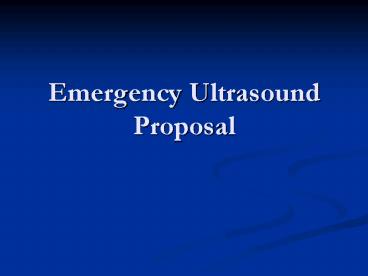Emergency Ultrasound Proposal - PowerPoint PPT Presentation
1 / 24
Title:
Emergency Ultrasound Proposal
Description:
'each hospital medical staff should review and approve criteria for granting ... Formal didactics. Practice sessions. Financial. Estimated Initial Expenditure ... – PowerPoint PPT presentation
Number of Views:273
Avg rating:3.0/5.0
Title: Emergency Ultrasound Proposal
1
Emergency Ultrasound Proposal
2
Emergency Ultrasound
- In common use since early 1990s
- First curriculum was published in 1994
- Supported by professional societies
- American Board of Emergency Medicine
- American College of Emergency Physicians
- Society of Academic Emergency Medicine
- Accreditation Council for Graduate Medical
Education - American Medical Association
3
AMA Resolution 802 (1999)
- ultrasound imaging is within the scope of
practice of appropriately trained physician
specialists - each hospital medical staff should review and
approve criteria for granting ultrasound
privileges in accordance with recommended
training and education standards developed by
each physician's respective specialty society
4
Benefits of an EUS Program
- Improved patient care
- Saves time
- Saves money
- Recruiting
5
Improved patient care
- Better door to diagnosis time
- Better door to treatment time
- Focused Ultrasound is performed in concurrently
with management of the patient - Improved patient satisfaction
6
Saves Time
- Ultrasounds often completed in minutes
- Not hours
- Decreased throughput time for ED patients
- Better door to diagnosis time
- Better door to treatment time
- Better ED bed efficiency
7
Saves Money
- Alternative to more complex, expensive studies
- Decreased use of limited resources for non-funded
patients - Avoid ED crowding caused by waiting for
completion of ultrasound study
8
Recruiting
- In 2003 the ACGME required all EM residencies to
provide Emergency Ultrasound training - This has become a litmus test for whether an EM
group is current - Some questions on standard of care
- Continued board certification
- Core Content of Emergency Medicine
- EM LLSA exam
- EM board certification exam
9
Emergency Ultrasound
- Limited , focused exams that ask specific
questions - Contrasted with formal ultrasound which is
intended as a full survey of the organ / system
in question.
10
Indications
- Is there blood in the abdomen?
- Is there a pericardial effusion?
- Is there an abdominal aortic aneurysm?
- Is there evidence of an IUP?
- Is there EMD?
- Is there evidence of Cholecystitis?
- Is there evidence of obstructive uropathy?
11
Is there blood in the abdomen?
Normal
Abnormal
12
Is there a pericardial effusion?
Normal
Abnormal
13
Components of an ED Ultrasound Program
- Equipment
- Training / Credentialing
- Quality assurance
- Emergency ultrasound program coordinator
14
Equipment
15
Requirements for ED Machine
Ease of Use
Image Quality
Image Report Management
Best Machine For ED Use
Special Features
Cost
Durability
Portability
Service Upgradeability Warranty
16
Purchase Goals
- Best Image Quality for Lowest Price
- Ease of Use for all users
- Image and Report Management/Wireless
- Initial Cost
- Portability
- Durability
- Warranty and On Going Cost
- Service and Reliability
- Presentation of Images to Patient
17
Training / Credentialing
- 2 step credentialing process
- Provisional
- A. Education- MD or DO AND
- B. Training- Board Certified or eligible in
Emergency Medicine OR
completion of residency in Emergency Medicine
AND - C. Experience - 25 supervised examinations or
25 cases with acceptable
verification as determined by the emergency
ultrasound director AND - D. 16 hours of a formal education that conforms
to the ACEP guidelines
18
Training
- Two options
- Each physician attend a formal course
- Expensive 800 x 26
- import a course here
- Use our own US machines
- Less expensive
- OKd by Medical Education
- Commitment by national EUS instructor
19
Training / Credentialing
- Full
- A. MD or DO AND
- B. Board Certified or eligible in Emergency
Medicine AND - C. Residency training in EUS with acceptable
verification OR - D. Performance of 150 total exams with
competence documented by ongoing
CQI review. - E. Letter of reference by the Emergency
Ultrasound Director.
20
Quality Assurance
- Performed by EUS director or other credentialed
EMPs - Purpose
- as a tool for education and feedback for
physicians completing the credentialing process - to monitor ongoing performance of physicians that
have completed the credentialing process
21
Quality Assurance
- The ultrasounds will be reviewed on three
criteria - Was the study indicated by the patients
presentation? - Was the study technically adequate?
- Was the interpretation correct?
- The findings of the review process will drive the
ongoing medical education in the form of - Journal Club
- Formal didactics
- Practice sessions.
22
Financial
Estimated Initial Expenditure Ultrasound
equipment (2) 80,000 (range 65k to
120k) Initial Training Course 5,000 (range up
to 21k 26 EPs x 800) Quality
Assurance 19,500 (range up to 40k if outside
QA) Ongoing Expenditure Paper, cleaner,
etc. 1000/year Insurance/maintenance 1000/yea
r Estimated Total Expenditure 104,500 plus
1000-2000 annual
23
Financial
Estimated Income Trauma APC 0266 and 0697
179.26 Estimated patients/year
480 Total 86,044 Approx 30
collection 25,813 Pregnancy/IUP APC
0266 92.74 Estimated patients/year
1095 101550 Approx 30 collection
30,465 Estimated Income, Trauma and IUP
only 56,278/year
24
Summary
- Significant benefit of emergency US program
- Minimal financial risk
- Supported by
- National societies
- Trauma
- Critical Care Committee
- Emergency Physicians































